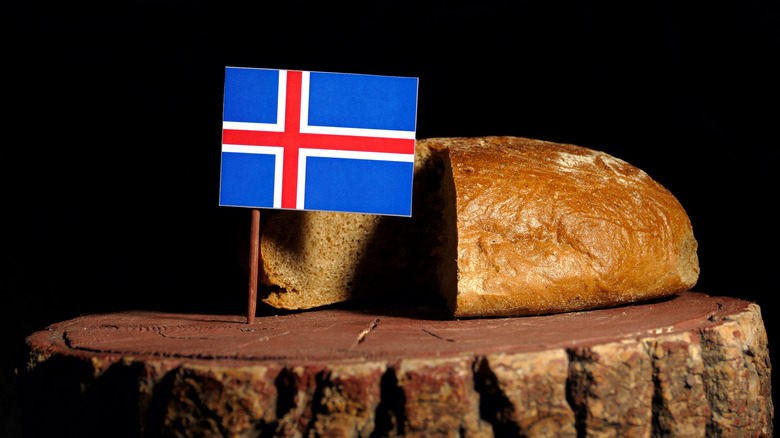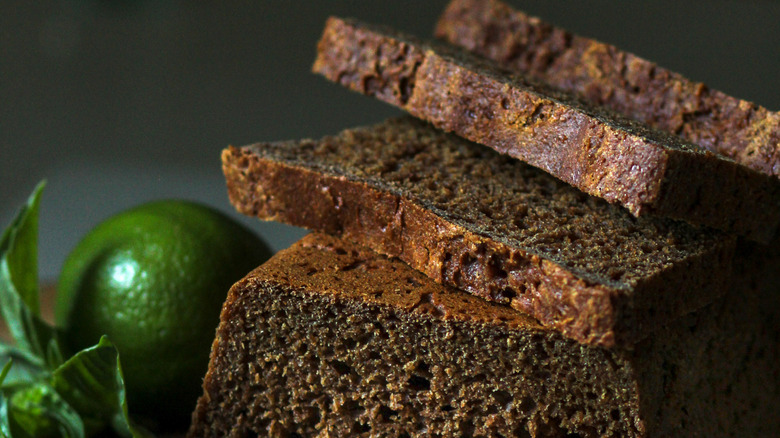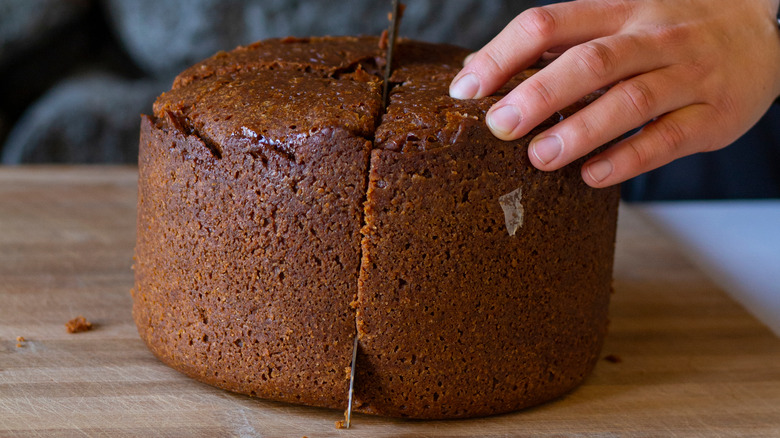Iceland's 'Hot Spring Bread' Bakes Underground For 24 Hours
While Iceland might be referred to as the "Land of Fire and Ice," the island nation full of glaciers and volcanic springs is full of juxtapositions. The rugged terrain and slightly isolated nature of being an island nation have residents becoming resourceful. Many of Iceland's most popular foods feature dishes that can last through those harsh wintery days (via Arctic Adventures). From preserved fish to hearty lamb stews, the foods and flavors are robust and flavorful. Although some visitors might prefer some Skyr in the morning versus cured shark meat, a trip to Iceland is not complete without at least a few traditional dishes.
Although Icelandic food might not be on some U.S. menus, Egill Halldorsson, co-owner and tour guide of Wake up Reykjavik and the Reykjavik Food Walk described the local food to Vogue as "Our fare has always been very simple because of our climate limitations and isolation from the world. Icelandic food is, in its simple form, uncomplicated, elegant and natural." That idea of "natural" even applies to how people cook their meals. Although some chefs might have every gadget in the kitchen, the resourcefulness of Icelandic cooks is clear with one of its iconic, native recipes. As seen with rúgbrauð, the Icelandic hot spring bread, the natural oven bakes this rye bread. Although not a simple process, the result is one worth tasting.
What is rúgbrauð and how do cooks make it?
According to Iceland Food Center, rúgbrauð is the most popular bread in Iceland. While there are various recipes of this traditional bread, it has become a staple because it can balance the other pungent foods on the table. From offsetting the robust flavor of a fermented fish or balancing the smoky notes in a dish, the Icelandic bread can be paired with almost anything. Traditionally made with rye grains because that ingredient was plentiful, that concept is another nod to Icelandic resourcefulness. A sourdough style bread with some sugar, the bread is cooked low and slow. Although not a barbecue style, the original baking method was due to the lack of ovens in homes.
As Thrillist explains, the traditional method of baking rúgbrauð uses the heat from natural hot springs to "bake" the rye bread. By utilizing the geothermal energy from the hot springs, bakers are able to "bury" the bread and allow it to slowly rise and develop its unique flavor. Depending on the baker, the process can take up to 24 hours. While there are various recipes for this traditional Icelandic fare, this rye bread is generally denser, and more cake-like than fluffy, traditional sandwich bread. Although this baking method might not become the next FoodTok, the ingenuity in the baking process is one that more foodies should discover.
How Icelandic cooks serve rúgbrauð
Although food history digs up the traditional method for baking the Icelandic rye bread, rúgbrauð recipes have been unburied from the ground and found their way to the kitchen oven. As the low, slow cooking method produces a dense, sometimes sweet, robust rye bread, many people wonder how the traditional loaf can be served. According to King Arthur Baking Company, there are a plethora of both traditional and non-tradition serving ideas. From topping it with some smoked fish to a briny pickled ingredient, the bread can offer balance to robust flavors.
Given the rye bread's flavor and texture, it lends itself to experimentation. From a simple topping of compound butter to even just enjoying it on its own with eggs at breakfast, there are many reasons to bake up a loaf to try. This traditional food sometimes makes an appearance at some people's holiday tables, too. Even if the recipe requires a little more planning to take into consideration the long baking time, whether in the oven or under the ground, the rúgbrauð proves that juxtaposition, just like fire and ice, can be a flavorful, worthwhile bite.


